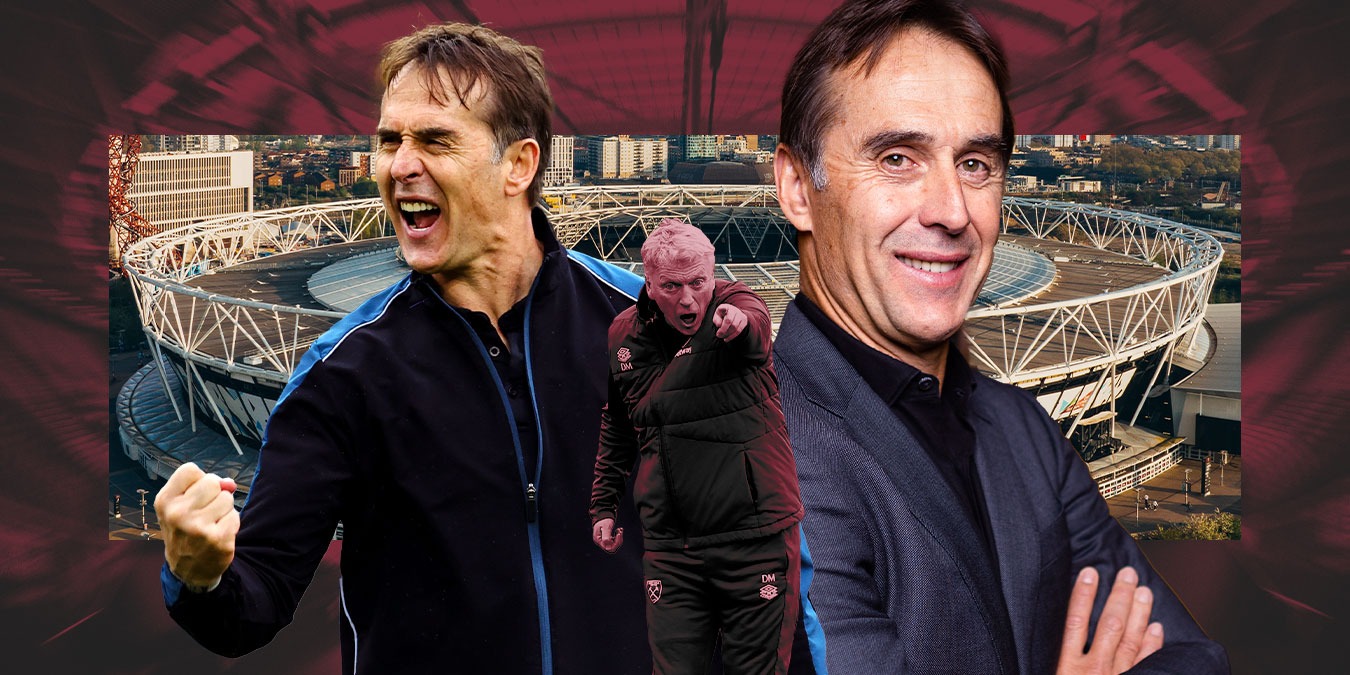David Moyes’ successor at West Ham will be Julen Lopetegui, but many supporters are unconvinced he’s the man to bring the attacking football they yearn for.
Julen Lopetegui has been patient. After leaving Wolves last August, the Basque coach has been biding his time in search of a new job. Only, it would appear he’s not a particularly popular choice anywhere among supporters.
After AC Milan fans kicked up a fuss about the prospect of the 57-year-old succeeding Stefano Pioli, creating a petition that attracted over 10,000 signatures in less than two days, negotiations between the club and Lopetegui broke off.
In stepped West Ham. On 6 May, it was announced David Moyes would be leaving his role as manager at the end of the 2023-24 season; reports to that effect had been rumbling for months, and in the few days prior to confirmation, those rumours ran alongside widespread speculation suggesting Lopetegui was in line to take over.
But, once again, he didn’t appear to be an overly popular choice. Another – albeit far less impactful – petition was started by Hammers fans, who also co-opted the ‘Nopetegui’ slogan Milan supporters coined.
West Ham’s treatment of Moyes led to criticism, and that perhaps explains some of the antipathy, while others were presumably seduced by the possibility of hiring Sporting CP’s highly regarded young coach Rúben Amorim after he held talks with the club in April.
Lopetegui in man West Ham have chosen, though, and despite the understandable doubts – more on that later – over his suitability, West Ham fans should feel optimistic about what he can offer the club.
It ought to be acknowledged that Moyes has did a fine job at West Ham. When he took over in December 2019, the club were in a relegation battle; since then, he’s led them to two top-seven finishes, the Europa League semi-finals and the Europa Conference League title, and he’s on course to leave with the best Premier League win percentage (37.9%) of any permanent Hammers manager.
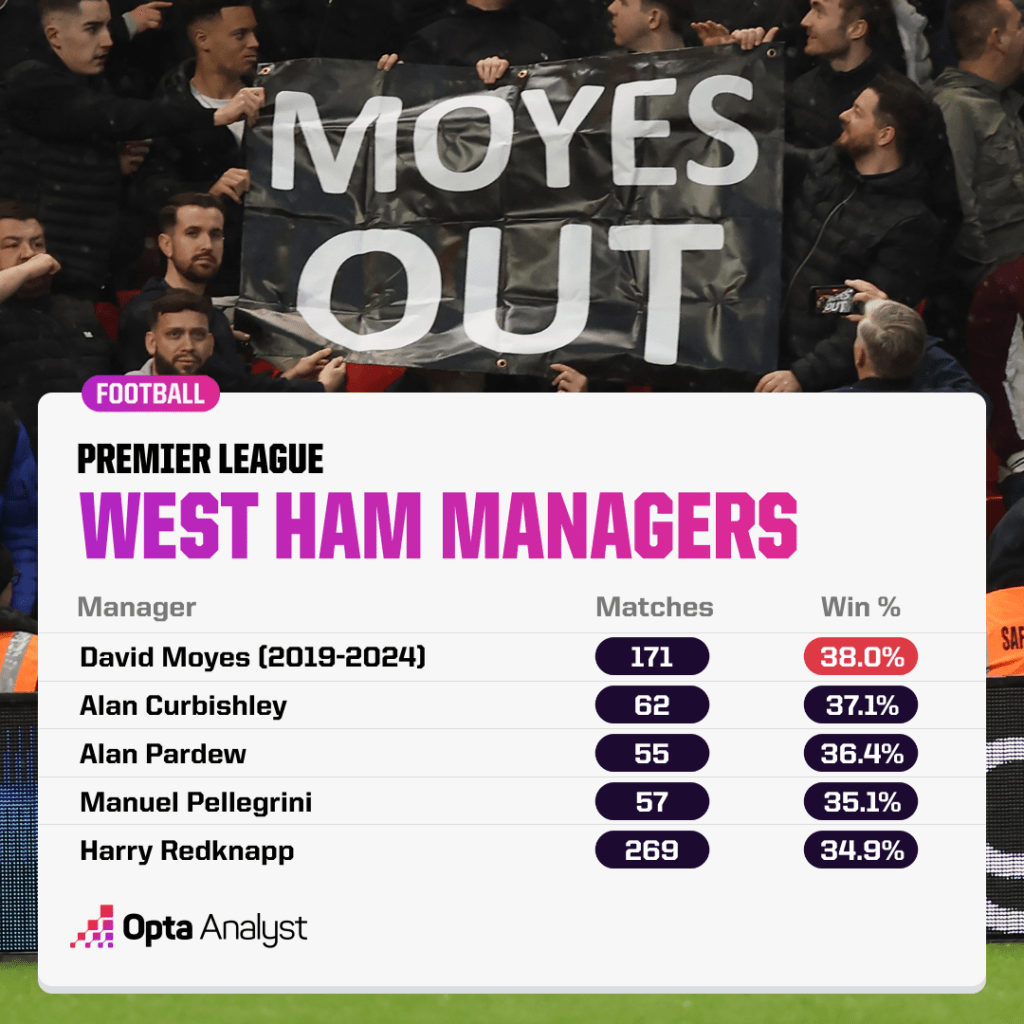
However, frustration with the style of football and a perceived lack of excitement has been a regular feature, which Moyes recognised in February. He said: “Maybe [the fans] have had managers who excite them more, but the one who is sitting here wins more. Maybe they want something different, but they’d honestly have to say it’s been as good a time as they’ve had at the club regarding winning a trophy, their league positions.”
Moyes has never been regarded as a great entertainer, and that’s fine. But in an age when even clubs coming up from the Championship are capable of dominating possession, zipping the ball around for fun and playing ‘pretty’ football, it’s understandable why supporters might be yearning to see something new. After all, certain sections of the support have been vocal in their in their discontentment, with ‘Moyes Out’ banners making appearances and ‘boring, boring West Ham’ being chanted in the stands. As the graphic below shows, they can’t be considered intricate.
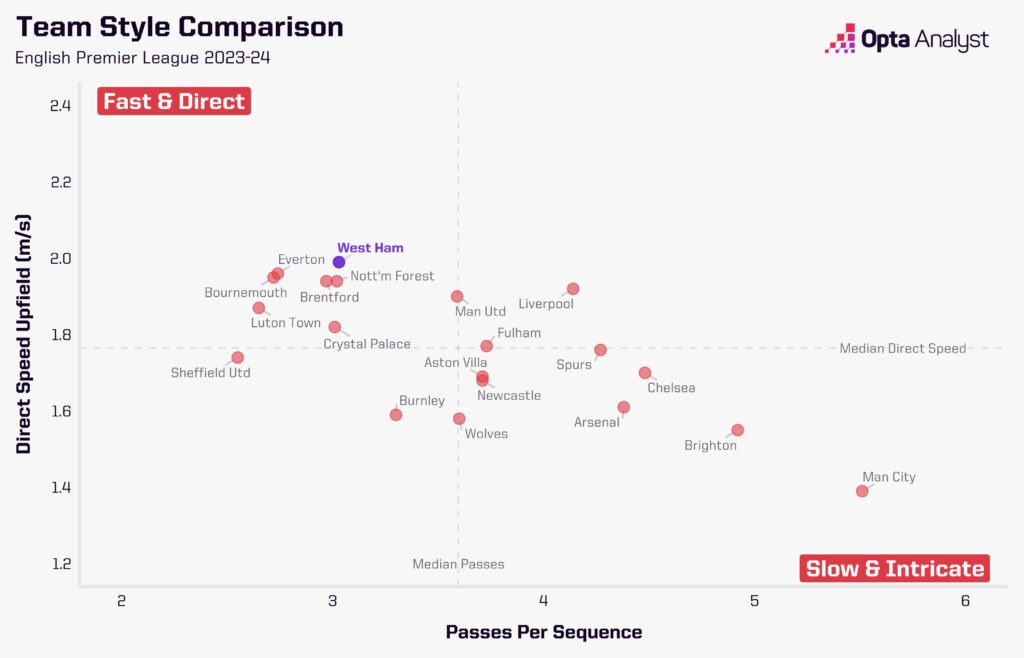
Lopetegui certainly isn’t an unknown quantity in the Premier League after spending time at Wolves last season, but his methods probably aren’t that familiar to West Ham supporters given his stay in the Midlands was fairly brief due to disagreements with the board.
He joined Wolves in November 2022 with the club bottom of the Premier League. He led them to safety in 2022-23, finishing a place above West Ham in 13th, which obviously reflects well on the coherence and direction of his coaching, but there’s only so much we can glean from such an extreme situation and limited time.
Lopetegui’s spell at Sevilla probably provides the greatest insights into how he operates and the player profiles he likes considering his three and a bit years there was the longest he’s spent at a club. And he also brought tangible results.
Early on in his time in Nervión, Lopetegui insisted he wasn’t “obsessed with having the ball more or not”, convinced he had to allow room for nuance rather than dogmatically fixate on one idea. Nevertheless, his Sevilla team could certainly keep the ball. They recorded at least 58% possession over each of his full three seasons in charge; the only other teams to achieve that over the same period were Barcelona and Real Madrid. It was something of a departure for the club, where wing play, counter-attacking and devastating transitions had become staples since the turn of the century, their glory years.
Similarly, the lowest they ranked in La Liga over those three campaigns for the number of open-play passing sequences comprising at least 10 passes was third, and in each season they were among the top four for the number of those passages that led to a shot or a touch in the opposition’s area.
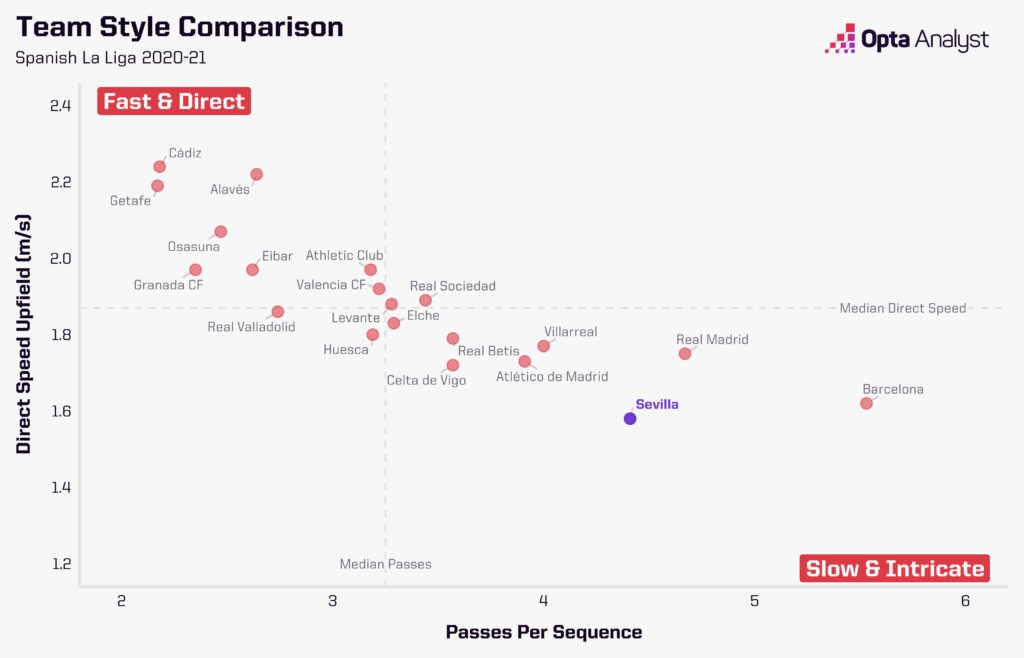
A big part of Sevilla’s greater focus on possession was the central trio of Jules Koundé, Diego Carlos and Fernando. Between them, they boasted an ideal blend of the physicality defenders need, technical quality and accurate distribution, providing a dependable bedrock where attacks could be built from. Koundé would venture forward towards the right, covering spaces vacated by right-back Jesús Navas and frequently stepping into attacking areas. Fernando would cover the Frenchman and also drop in to help form a back three when in possession.
But that trio – along with the goalkeeper, Yassine Bounou for the most part – were also essential to what was the defining element of Lopetegui’s Sevilla: their defensive solidity.
From the start of 2019-20 until the end of 2021-22, Sevilla kept 73 clean sheets in 160 games across all competitions. That equated to recording shutouts in 45.6% of their matches over that time, which was second only to Manchester City (46.1%) among teams from the big five leagues.
Domestically, only they and Real Madrid tallied at least 17 clean sheets in each of the three campaigns in question, while Sevilla were the one La Liga club to keep their expected goals against (xGA) below 37.5 every year; this averaged out to 0.96 xGA per game during Lopetegui’s three full seasons, bettered by just Atlético Madrid (0.92), clear evidence that they consistently restricted their opponents’ flow of clear-cut chances.
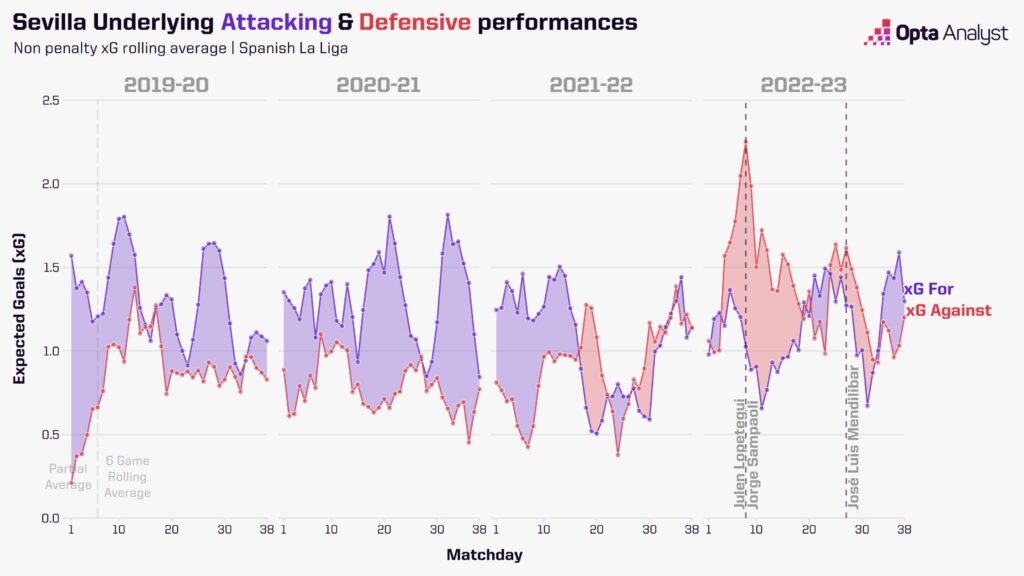
For many clubs these days, employing a high press is the cornerstone of their approach off the ball, but Lopetegui’s Sevilla didn’t quite fall into that category. They would sit quite deep and as a result they ranked 10th, 13th and 18th for high turnovers – instances of winning the ball back within 40 metres of the opponents’ goal – in the respective full seasons under Lopetegui. But, just because they didn’t press so much in the attacking third doesn’t mean they didn’t work hard; in fact, they were pretty tireless out of possession, just slightly closer to their own goal.
Over the three seasons outlined, on average Sevilla allowed their opponents just 10.3 passes before engaging with a defensive action (PPDA), with only four clubs recording lower averages for that time span.
A knock-on effect of their defensive shrewdness was that they didn’t exactly score lots of goals. Now, La Liga is a low-scoring competition, its seasonal average for goals per game over the past decade is 2.62, the lowest among the top five leagues. So, that is a factor, but the original point stands. During Lopetegui’s three full seasons in charge, Sevilla’s best non-penalty goals per game figure was 1.34 in 2021-22; West Ham have averaged more under Moyes in the 2023-24 (1.47), 2021-22 (1.47) and 2020-21 (1.58) Premier League seasons.
But of course, Sevilla didn’t need to score lots because of how controlled and defensively sound they were. They still had their desired routes to goal, though, and a lot of that revolved around freeing up space for the full-backs to bomb on out wide while the three central midfielders and inverted wingers cultivated control in the middle.
Crossing was a major focus. They recorded 576 or more open-play crosses in each season under Lopetegui, going as high as 679 in 2019-20; they never ranked lower than sixth in La Liga for such deliveries, which also reflected the type of striker Lopetegui nearly always wanted leading the line.
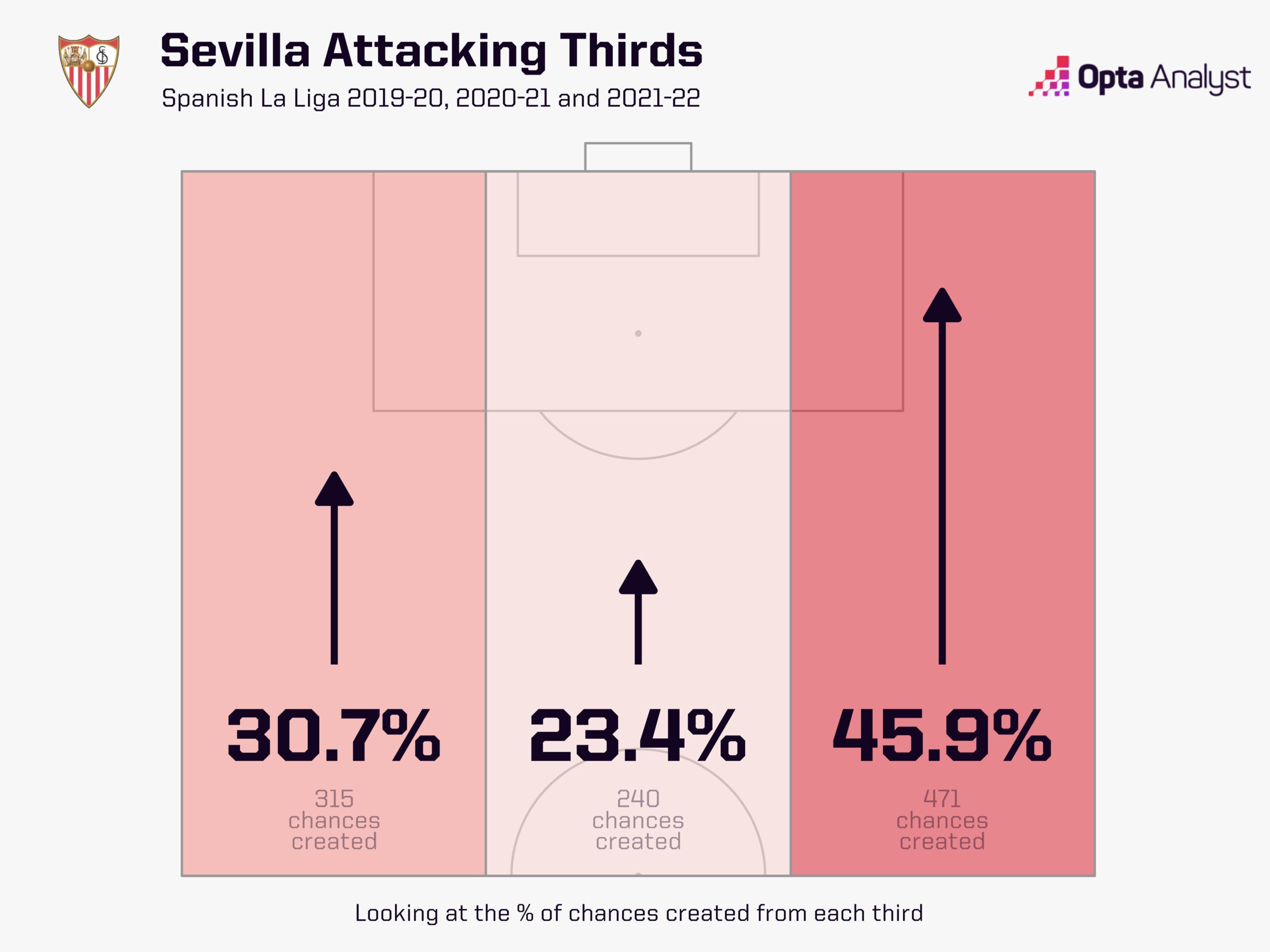
Luuk de Jong, Youssef En-Nesyri and Rafa Mir were all signed by Monchi for Lopetegui. All three share the characteristics that they are tall and very good in the air, and while En-Nesyri is the only one who could be considered an unequivocal success, their respective arrivals all spoke volumes about what the coach wanted.
En-Nesyri and Mir joined after De Jong struggled to translate his Eredivisie goals output to La Liga, and both brought greater intensity, mobility and energy to the role than the Dutchman. One thing remained consistent, though; in each season, Sevilla reached double figures for headed goals in the league, with Osasuna the only other La Liga club to achieve that over the same period.
In short, most who watched them would agree that Lopetegui’s Sevilla weren’t particularly exciting. They were, however, incredibly effective and resolute, and very good at what they were set up to do, which was keep the ball, keep their opponents at bay and win matches.
If, just for argument’s sake, Lopetegui’s West Ham side were to replicate the style developed at Sevilla, it’s very likely that supporters won’t get the exhilarating football they seemingly desire, but there’s a strong case for him improving them and making them a much better football team across the board.
Of course, the idea of exactly replicating his setup at Sevilla isn’t particularly probable because, as he said in his very first press conference at the club, “it’s all very well sketching things but the important thing is that [the system] plays out in real situations; style is an important thing but we’ll look for the best style for the squad we have”.
In that sense it’s pretty difficult to predict precisely what most of the defining elements of Lopetegui’s West Ham will be, other than an attempt to control possession. Will they be very entertaining? Well, entertaining is a subjective term, so quite possibly not to everyone, no. Will they be progressive and look to dominate the ball? Almost certainly.
It should also be highlighted that Lopetegui’s fine work at Sevilla came against the backdrop of vast squad upheaval. In his first season, 15 new players arrived over the course of the campaign and 19 left. This was essentially an entirely new squad, and he quickly moulded them into a team that went on to win the Europa League and finish fourth in La Liga for only the second time since 2010. There can’t be many greater indicators of a manager’s coaching ability than that.
He’d ultimately become the first coach in Sevilla’s history to lead them into the Champions League/European Cup three seasons in a row, and their back-to-back-to-back top-four finishes was a first for the club since the Spanish Civil War.
Success and excitement don’t always go hand-in-hand in football, but West Ham fans can feel safe in the knowledge that Lopetegui is a progressive coach with a track record of getting his ideas across quickly and subsequently improving teams.
To get a coach of his calibre, foregoing a pursuit of no-holds-barred excitement could be a very smart sacrifice.
Enjoy this? Subscribe to our football newsletter to receive exclusive weekly content. You should also follow our social accounts over on X, Instagram, TikTok and Facebook.
